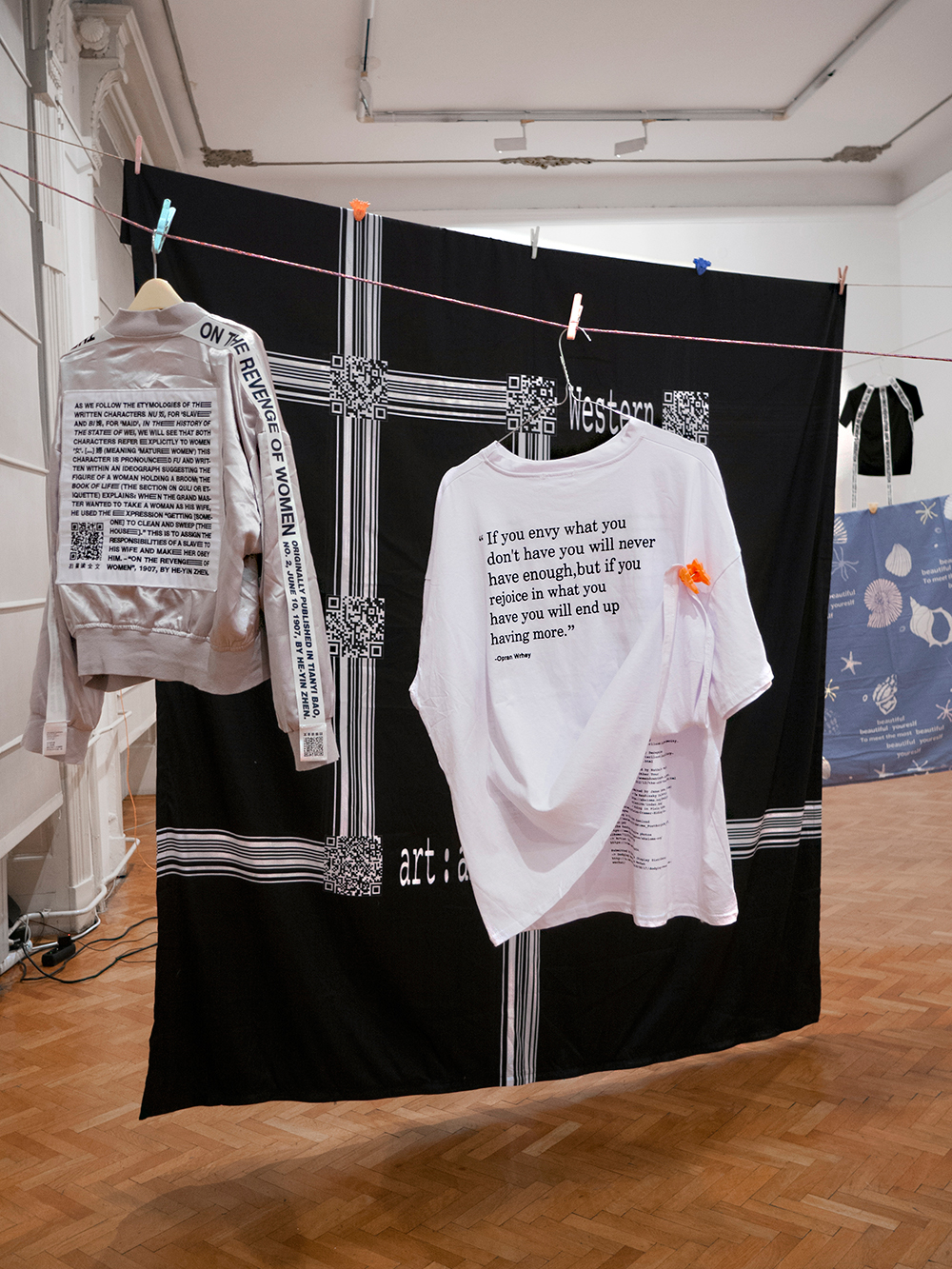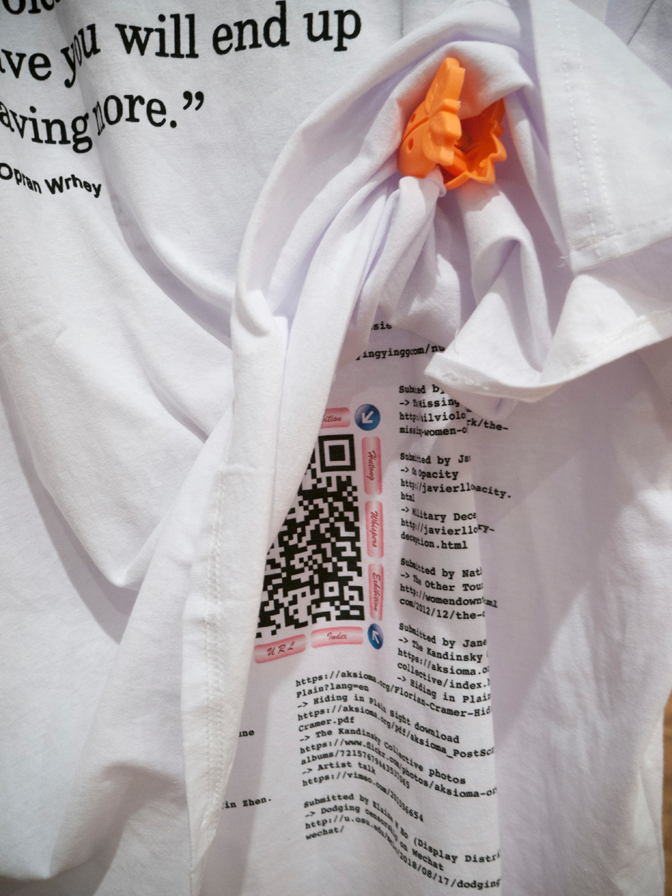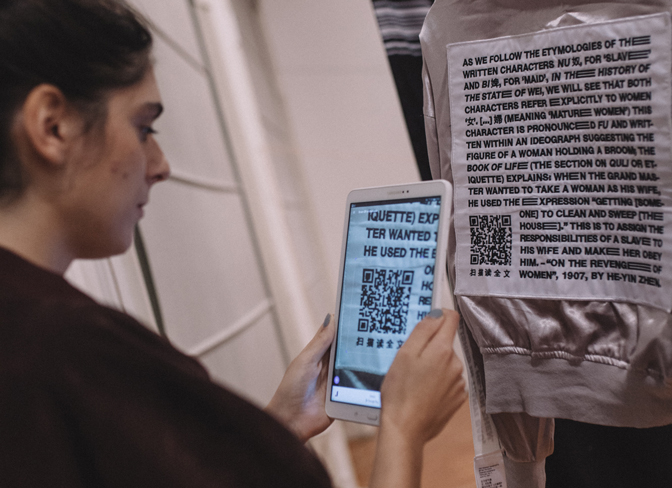Hutong Whispers
2018

What: Solo exhibition
Where: Drugo More, Rijeka, Croatia
When: 8 - 23 November, 2018
The verb ‘to launder’ refers to the act of legitimising illegally obtained money to wash away its questionable traces. In contrast, the idiom ‘to air out dirty laundry’ is analogous to disclosing secrets publicly. The first speaks of erasure, removal, suppression, censorship, while the latter speaks of revealing, talking, leaking, publishing.
The exhibition Hutong Whispers is a steganographic catalogue of steganographic* publishing projects camouflaged as a laundry line. The exhibition co-opts three omnipresent elements in the Chinese urban landscape – bedsheets; Shanzhai fashion, a Chinese phenomenon that features nonsense English; and QR codes – exploring them as covert media to publish sensitive and suppressed knowledge. This installation is designed to be eventually placed back into the traditional residential alleys of Beijing or hutongs, so that it may return back to its natural habitat, the context by which it was originally inspired.
Inside the hutongs, bedsheets and blankets are hung on laundry lines that stretch from entrances of homes onto the street. They can be read as transgressive objects because of their migratory nature trespassing the lines between public and private. Bedclothing is also perfect cover, literally and metaphorically. The blanket is a nondescript agent, detectable but unremarkable. Because of its ordinariness, it is free from suspicion and can smuggle (air out) private information to the public setting.
Shanzhai fashion is similarly ripe for steganographic instrumentalisation. Its English characters are not designed to be read but rather to function as an ornament and value signifier of Western culture, embodying ‘high culture’, ‘edginess’ and ‘coolness’. However, for English readers, texts may appear as dada poetry, accidental wisdom or absurd word salads. Hutong Whispers takes advantage of the illegibility of English in the context of its use as ornamentation, staging the aestheticisation of foreign language as a steganographic medium.
The final tactical site for steganography is the QR code, a technology made massively popular in China thanks the QR scanner built into WeChat, the nation’s most widely used app. To give an idea of its level of ubiquity: Informal street vendors and beggars use QR codes as modes of transaction. In light of QR’s pervasive visual presence, it inadvertently provides guileless disguise for sensitive knowledge to travel.
Hutong Whispers reconfigures previous work into hidden information. The first piece, Thunderclap (2017), is a steganographic zine that piggybacks on fashion accessories as a publishing surface for the erased writings of Chinese anarcho-feminist He-Yin Zhen (1886-1920). Another work featured is The Choice of a Translator (2018), the transcription of a talk on censorship and steganography given in Beijing wherein a suspected government spy was part of the audience. The transcript reveals how the translator reshapes and depoliticises the content of the talk, positioning the act of translation as a tool for censorship and steganography.
Hutong Whispers also includes its genesis, a selection of tactical and strategic uses of steganography that inspired the exhibition. As a whole, the project functions as a basic technical primer on steganography as a type of secret writing. Last but not least, the show includes related projects and references submitted by Clara Balaguer (Hardworking Goodlooking), Dušan Barok (Monoskop), Kelly Doley, Jessie Yingying Gong, Linda Zeb Hang, Elaine W. Ho, Janez Janša (Aksioma Institute), Woodstone Kugelblitz, Javier Lloret, Silvio Lorusso, Nadine Stjins and Nathalie Wuerth.
* Steganography is a form of secret writing – the art and science of disguising hidden information within public information. At the centre of this practice is the instrumentalisation of the innocent to evade surveillance, censorship and control.













Opening night photos




 Photos by Tanja Kanazir
Photos by Tanja Kanazir




